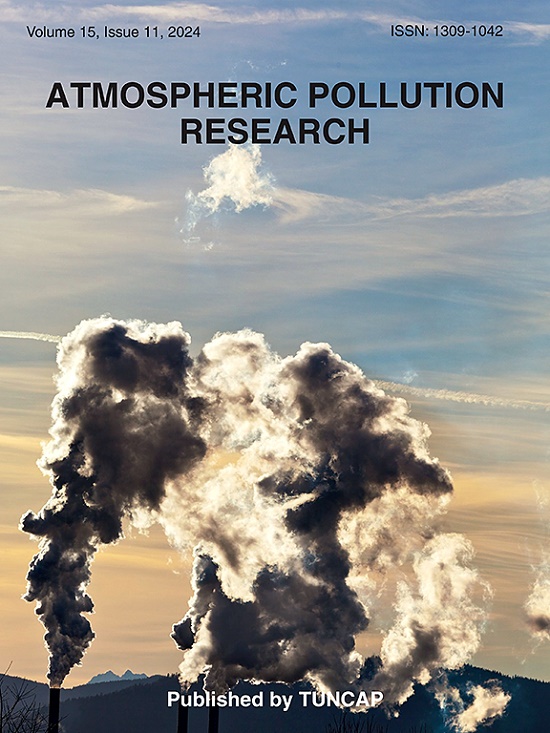Characteristics and sources of water-soluble organic nitrogen in PM2.5 from a resource-dependent city
IF 3.5
3区 环境科学与生态学
Q2 ENVIRONMENTAL SCIENCES
引用次数: 0
Abstract
Water-soluble organic nitrogen (WSON) are important fine particles (PM2.5) fractions consisting complex mixtures, while their spatiotemporal characteristics and sources are not fully understood, especially within regions of intense industrial activities and arid climate. Focusing on seasonal pollution characteristics of Wuhai, this work analyzes the relationships between WSON and indicators such as water-soluble organic carbon, water-soluble ions, organic carbon, and elemental carbon, and elucidates the sources of WSON in Wuhai's PM2.5. The results indicated that WSON concentrations in PM2.5 during the heating and non-heating seasons were 2.36 ± 2.14 μg/m3 and 0.78 ± 0.37 μg/m3, respectively, showing a seasonal pattern with higher levels in the heating season, consistent with other chemical components of PM2.5. The significant correlations between WSON and SO42−, NO3−, NH4+, Cl−, K+, OC, and EC in both seasons suggested that the sources of WSON included secondary aerosol formation, coal combustion, biomass burning, and vehicle exhaust emissions in Wuhai. The N:C ratio indicated that amino acids and organic nitrates may be major components of WSON in the studied city. The NO3−/SO42− ratio revealed that PM2.5 level was primarily influenced by fixed combustion sources, particularly during the heating season. The PMF model showed significant seasonal differences in WSON sources, with coal combustion (56.61 % in heating season, 42.47 % in non-heating season) and vehicle emissions (30.87 % in heating season, 25.64 % in non-heating season) being major sources. This study is crucial for understanding atmospheric nitrogen cycles and estimating nitrogen deposition, and provides practical insights for controlling WSON pollution in northwestern inland cities with prominent seasonal pollution characteristics.
某资源型城市PM2.5中水溶性有机氮特征及来源
水溶性有机氮(WSON)是重要的细颗粒物(PM2.5)组分,由复杂的混合物组成,但其时空特征和来源尚不完全清楚,特别是在工业活动强烈和气候干旱的地区。本文围绕乌海市的季节性污染特征,分析了WSON与水溶性有机碳、水溶性离子、有机碳、元素碳等指标的关系,阐明了WSON在乌海市PM2.5中的来源。结果表明:采暖季WSON PM2.5浓度为2.36±2.14 μg/m3,非采暖季WSON PM2.5浓度为0.78±0.37 μg/m3,采暖季WSON PM2.5浓度较高,与PM2.5的其他化学成分一致;两个季节WSON与SO42−、NO3−、NH4+、Cl−、K+、OC和EC的相关性显著,表明乌海WSON的来源包括二次气溶胶形成、煤炭燃烧、生物质燃烧和汽车尾气排放。N:C比值表明,氨基酸和有机硝酸盐可能是研究城市WSON的主要成分。NO3−/SO42−比值表明,PM2.5水平主要受固定燃烧源的影响,特别是在采暖季。PMF模型的WSON来源存在显著的季节差异,燃煤(采暖季占56.61%,非采暖季占42.47%)和汽车排放(采暖季占30.87%,非采暖季占25.64%)是主要来源。该研究对了解大气氮循环和估算氮沉降具有重要意义,为西北内陆城市季节性污染特征突出的WSON污染控制提供了实践见解。
本文章由计算机程序翻译,如有差异,请以英文原文为准。
求助全文
约1分钟内获得全文
求助全文
来源期刊

Atmospheric Pollution Research
ENVIRONMENTAL SCIENCES-
CiteScore
8.30
自引率
6.70%
发文量
256
审稿时长
36 days
期刊介绍:
Atmospheric Pollution Research (APR) is an international journal designed for the publication of articles on air pollution. Papers should present novel experimental results, theory and modeling of air pollution on local, regional, or global scales. Areas covered are research on inorganic, organic, and persistent organic air pollutants, air quality monitoring, air quality management, atmospheric dispersion and transport, air-surface (soil, water, and vegetation) exchange of pollutants, dry and wet deposition, indoor air quality, exposure assessment, health effects, satellite measurements, natural emissions, atmospheric chemistry, greenhouse gases, and effects on climate change.
 求助内容:
求助内容: 应助结果提醒方式:
应助结果提醒方式:


